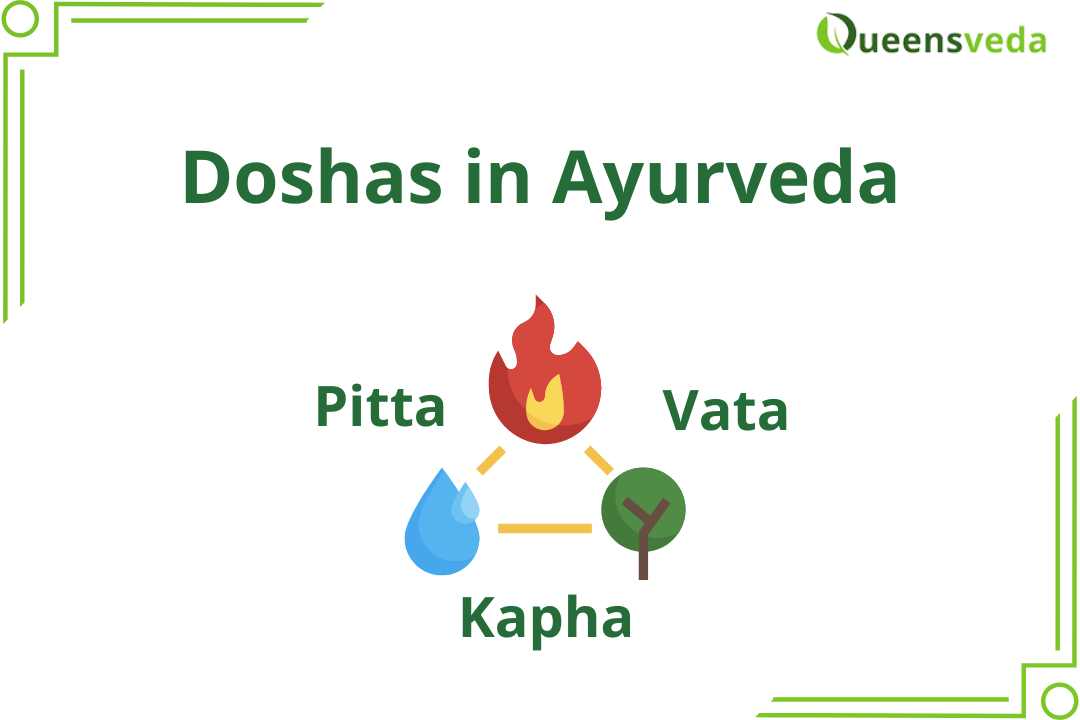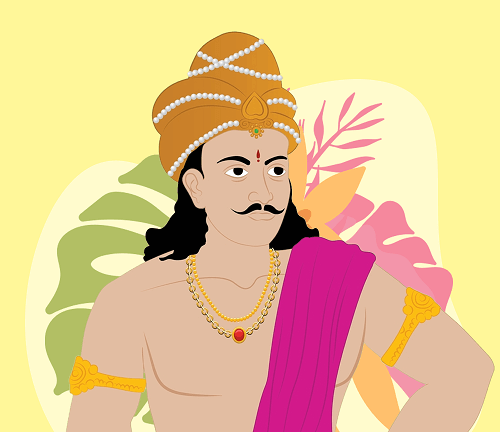Explaining 3 doshas in ayurveda and how does it affect our body. Also know what is the ayurvedic treatment for doshas imbalance.
Body, mind, and behavior are the three divisions made by India’s traditional medicinal system, Ayurveda. Vata, Pitta, and Kapha are the names of these three doshas. Cell signaling, cell division, mobility at all physiologic levels, waste disposal, and cognition are all in the Vata dosha category. Additionally, Pitta and Kapha’s activity is controlled by Vata. Kapha dosha is responsible for anabolism, development, structural maintenance, and storage and stability. The Pitta dosha group covers the metabolic, thermoregulatory, energy homeostasis, pigmentation, visual, and attentional processes.
The doshas are fundamentally natural energetic forces and practical concepts that can be used to comprehend better who we are and how the world works. No dosha is better than or superior to any other since each of the three doshas—Vata, pitta, and Kapha—is necessary in some way for our physiology. Each of them performs a somewhat specialized set of bodily functions. However, when the doshas are out of harmony, our health can suffer greatly.
But before diving into the particulars of each of the three doshas, it is helpful to grasp their fundamental bring and wider function in the natural world.
The five elements are considered the most fundamental components of Ayurveda’s universe- (space, air, water, earth, fire),
- The flexible quality of Wind (Air) energy defines Vata.
- Pitta depicts the Fire energy’s capacity for transformation.
- And Kapha reflects the tying quality of Water energy.
Everybody and everything possesses all three of the doshas, though in varying degrees, just like the elements. They interact to produce various climatic conditions, dietary preferences, species, and even variations among members of the same species.
The specific proportion of Vata, Pitta, and Kapha in each of us determines our physical, mental, and emotional character traits and particular strengths and vulnerabilities. Each dosha is identified by a group of characteristics that support its unique energy:
Due to the Ayurvedic principle that opposes creating equilibrium, these traits make dosha balancing extremely obvious.
In general, we can encourage a restoration to equilibrium when one of the doshas is accentuated by lessening the effect of that dosha’s traits and favoring their opposites. And if we know the exact traits that need to be calmed, we can concentrate on doing so while favoring activities, meals, and plants that intensify the opposite energies.
Doshas in Ayurveda and Their Purposes-
- Vata is responsible for movement and communication.
- Digestion and transformation are in charge of Pitta.
- Kapha offers Lubrication, Cohesiveness, and Structure.
The specific combinations of ingredients and attributes that each of the three doshas possesses give each one of them a distinct personality. At the end of the day, each dosha naturally controls particular bodily processes:
Though the doshas can be found throughout nature, they are most helpful for comprehending living things, including ourselves. We shall examine their fundamental roles in the context of human physiology as a result.
Vata-
Vata is frequently linked to the wind because it incorporates the energy of movement (and the air element). Vata regulates all activity, including all muscle contractions, tissue motions, cellular mobility, and communication within the mind and nervous system. It is associated with creativity and flexibility.
Pitta-
Pitta is intimately related to the fire element since it symbolizes the power of transformation. Water is pitta’s secondary element because it is primarily liquid in living things. Pitta is neither mobile nor stable but spreads, similar to how spreads, similar to the way a fire warms its surroundings or how water flows in the direction dictated by its surroundings.
Kapha-
Since Kapha gives everything structure, stability, and cohesion, the earth and water elements are its main associations. The watery qualities of love and compassion are likewise embodied by Kapha. This dosha hydrates all cells and systems lubricates the joints, moisturizes the skin, boosts immunity, and shields the tissues.
Understanding Dosha imbalances:
Dosha imbalances are typically brought on by unsupportive dietary and lifestyle decisions and stress or emotional trauma. The natural internal harmony represented is generally disrupted by these variations. Each of the doshas affects the body differently when it is agitated. Consequently, each of the three doshas—Vata, Pitta, and Kapha—is linked to a particular set of health issues and patterns for disease.
We are all inclined to excess in any of the three doshas, but we also tend to have an imbalance in our dominant dosha. In other words, people who are predominantly Vata-pitta will typically be more inclined to Vata and pitta imbalances than Kapha imbalances.
Vata imbalance-
Vata tends to produce dread, anxiety, loneliness, and weariness when out of balance. It can inhibit effective communication, result in physical and emotional exhaustion, and create a variety of abnormal motions in the body, including symptoms, mood changes, and muscle aches.
Inconsistent Pitta-
Pitta is a hot, reactionary energy that can lead to feelings of annoyance, rage, jealousy, and criticism when it is out of balance. Inflammatory illnesses, which can damage organs and tissues throughout the body, are frequently caused by an unbalanced pitta.
Inconsistent Kapha-
When Kapha is out of balance, it can produce stubbornness, lethargy, and aversion to change as well as feelings of attachment, avarice, and possessiveness. On a physical level, Kapha tends to encourage stagnation and congestion in all of the body’s organs and tissues, including the mind.
Signs of doshas-
- Dry lips, ears, joints, hair, and skin
- Internal system dryness causes bloating, gas, constipation, dehydration, and weight loss.
- Feeling uneasy and lightheaded
- Extremely cold
- Strange aches, constrictions, and muscle spasms
- Lip and skin texture roughness
- Excessive excitement, twitching of the muscles, anxiety, and restlessness
- Lack of weight gain and low weight
- Insomnia or sleep disruption
Ayurvedic Treatment for Pitta, Kapha, and Vata-
By adding particular herbal medicines and recipes, the three Doshas can be balanced. There are several treatments available in Ayurveda for the Vata, Pitta, and Kapha Doshas. Look here as we discuss those medications in this area.
Ginger:
Including ginger in your diet and tea helps lessen joint pain and increase muscle strength, which can help you manage the signs and symptoms of too much Vata. The use of ginger may aid in reviving the body’s ideal Vata balance.
Cardamom (Elaichi):
All three doshas can be balanced with the beneficial spice cardamom (Vata, Pitta, Kapha). Cardamom can improve digestion, lessen bloating, and regulate gas problems when there is too much Vata, ultimately calming it. Cardamom can be used to flavor food and beverages as well as to freshen breath by chewing on the seeds or eating the seeds.
Haldi:
Haldi, often known as turmeric, is a staple in Indian cuisine and has a strong Ayurvedic significance. Regular, moderate haldi use can assist to promote metabolism, blood circulation, and heart health. Curcumin, a component of turmeric, has anti-inflammatory, antioxidant, and anti-cancer effects. In addition, it can aid in reducing too much Vata in the body. Consuming turmeric is now easier than ever because of our Turmeric sparkles.
Withania somnifera:
Often known as ashwagandha, is a herb that has been used for centuries in Ayurveda to promote health. The powdered form of ashwagandha is said to aid in stress management, anxiety reduction, and the treatment of insomnia. The herb Ashwagandha also possesses revitalizing and Vata-balancing qualities. The benefits of ashwagandha can be obtained by taking it orally as Ashwagandha Sparkles, a herbal jam, pills, or raw powder.
Brahmi (Bacopa monnieri):
Brahmi is an Ayurvedic herb that can help balance emotions since it has stress-relieving effects. In addition, Brahmi can help restore a healthy Vata dosha and enhance sleep quality. Brahmi Ghritham can help maintain ideal Vata levels, improve cognition, and reduce stress when taken in the recommended dosages twice daily before meals.
Furthermore, you can also take Ayurvedic Queensveda Total Detox, which
helps to balance the Vata in your body, and makes a change in your diet and lifestyle habits. Also, it helps you get relief from doshas imbalance, constipation, and much more. Since it is made up of just Ayurvedic herbal ingredients, it is a guaranteed treatment for the doshas imbalance issues. Additionally, this comes in two varieties so that you can pick between the two options, one in powder form and the other in churan form.
Since it has no negative effects, there is no issue with taking it frequently. Consuming the nutrients it is built of in a normal way keeps your body healthy and you do not have any additional difficulties. If you consistently consume it, you will see the benefit within three to four months, and your doshas imbalance-associated issue will also be resolved.
So you can try this for better and more effective results for your doshas imbalance-associated issues.






One thought on “3 Doshas in Ayurveda and Its Effect on our Body”
Comments are closed.